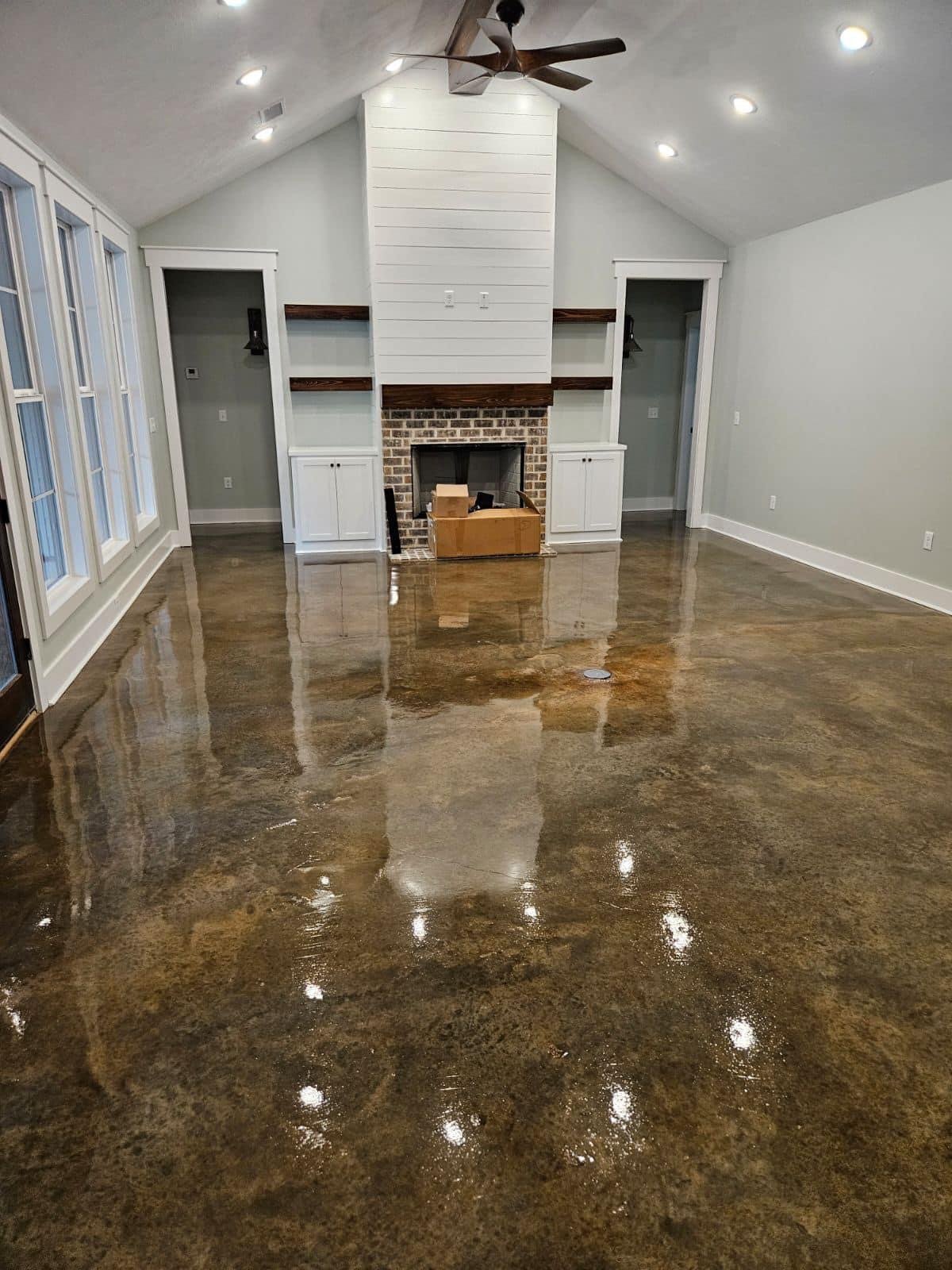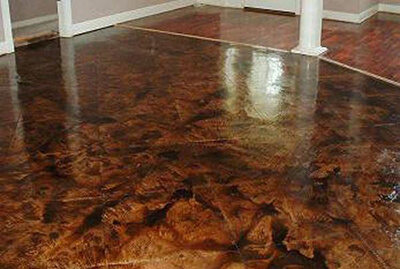How to choose before hiring contractors for stained concrete floors austin
Understanding the Various Types of Stained Concrete for Your Following Project
Stained concrete deals different options that cater to different visual and useful requirements. Each type provides distinctive qualities that affect the final look and toughness of the surface area. Comprehending these differences is vital for any person preparing a project. From rich, chain reactions of acid-based stains to the vivid uniformity of strong shade stains, the choices can significantly impact the outcome. What elements should one consider when picking the suitable discolor for their specific demands?
Summary of Stained Concrete
Stained concrete works as a versatile floor covering choice that can improve the aesthetic charm of different areas. This technique entails using a coloring representative to the surface of existing concrete, permitting a broad range of style possibilities. Stained concrete is preferred in both property and commercial settings, providing a durable and low-maintenance option that can simulate the appearance of all-natural materials like rock or ceramic tile.
The discoloration procedure can be performed using water-based or solvent-based items, each giving distinct aesthetic impacts. The last look is affected by factors such as the initial concrete surface area, the sort of stain utilized, and the application technique. Stained concrete not only beautifies exterior and interiors however also advertises sustainability by rejuvenating existing concrete frameworks. Because of this, it has gained traction amongst property owners and developers looking for both capability and design in their floor covering choices.
Acid-Based Stains: Features and Benefits

Special Shade Variations
Concrete surface areas can change dramatically with the application of acid-based stains, which supply an abundant palette of special shade variations. These stains permeate the concrete, responding chemically to generate vibrant earth tones that vary from deep browns and reds to soft eco-friendlies and blues. The resulting colors are commonly variegated, producing an all-natural, marble-like look that enhances the concrete's character. Each application yields unique results because of variations in the concrete's make-up and the discoloration technique used, making every project special. In addition, acid-based stains can be split or incorporated with other techniques to produce personalized styles, enabling for individual expression. This versatility makes acid-based stains a preferred choice for both property and commercial applications.
Chemical Responses Discussed
While several variables add to the effectiveness of acid-based stains, the underlying chemical reactions play an important function in their special characteristics and advantages. These stains mostly contain water, acid, and metallic salts. When related to concrete, the acid responds with the calcium hydroxide in the cement, developing a chemical improvement that leads to long-term color modifications. The metal salts permeate the surface and bond with the concrete, enabling a vast range of colors and tones. This response not only enhances aesthetic appeal but additionally provides sturdiness, making the shade immune to fading and wear. Additionally, acid-based stains can produce a variegated finish that simulates all-natural rock, more boosting their popularity for ornamental concrete applications.
Surface Area Preparation Significance
Attaining suitable outcomes with acid-based stains rests on detailed surface preparation. This important action assurances that the concrete surface area is clean, without contaminants, and correctly profiled for suitable discolor absorption. Any kind of existing sealers, dust, or oils can impede the chain reaction that generates the wanted shade and coating, leading to irregular or uneven outcomes.
Prior to using the stain, the concrete must be mechanically cleaned or pressure cleaned, adhered to by a detailed examination for cracks or flaws that might need fixing. Furthermore, confirming the surface area is effectively dried will certainly improve discolor adherence. By prioritizing these primary procedures, the longevity and vibrancy of acid-based stains can be considerably improved, resulting in an extra visually pleasing and durable surface.
Water-Based Stains: Features and Advantages

Water-based stains pass through the concrete, supplying a much more translucent coating that highlights the natural structure and variations of the surface area under. They are readily available in a large range of colors, enabling imaginative versatility in style. Additionally, water-based stains are easier to clean up, needing just water and soap, which simplifies the application process.
Their quick drying time boosts performance, making them a practical option for both DIY lovers and specialists. In general, get more info water-based stains supply an attractive combination of visual versatility and easy to use properties, making them a prominent alternative for concrete improvement tasks.
Solid Color Stains: Vivid Choices for a Bold Appearance
Solid color stains use an effective remedy for those seeking to develop a strong and vibrant visual on concrete surface areas. These stains provide a consistent coloration that can drastically boost the aesthetic appeal of floors, patios, and driveways. Offered in a broad range of hues, solid color stains enable creative expression, accommodating different design choices.
One of the crucial advantages of solid color stains is their capacity to hide blemishes, providing a fresh and refined appearance to maturing concrete - Austin Stained Concrete Floors. Additionally, their solution normally consists of UV-resistant buildings, guaranteeing durability and shade retention also in severe weather condition problems
Application is uncomplicated, needing marginal prep work of the concrete surface area. Once applied, strong color stains can be secured for included security and luster, more raising their aesthetic top quality. With their vibrant choices, strong shade stains are an excellent choice for those intending for an impactful and cohesive style.
Semi-Transparent Stains: Achieving Deepness and Measurement
Semi-transparent stains use a special strategy to improving concrete surfaces by providing depth and dimension with various shade options. Comprehending the application techniques is important for achieving the preferred result, while proper maintenance techniques assure long life. This section will certainly check out these essential facets to make best use of the advantages of semi-transparent discoloration.
Color Options Available
A wide variety of shade options exists for semi-transparent stains, enabling property owners and designers to improve the natural charm of concrete surfaces. These stains come in a variety of tones, from natural tones like browns and terracottas to vivid colors such as blues and eco-friendlies. The semi-transparent nature of these stains permits the underlying concrete to show with, developing a distinct deepness and measurement that can match various layout appearances. In addition, combining different colors can create personalized shades, enabling a customized search for each project. This versatility makes semi-transparent stains a prominent choice for both indoor and exterior applications, as they can integrate with surrounding components while including visual passion to ordinary concrete.
Application Methods Clarified
To accomplish the desired deepness and dimension with semi-transparent stains, proper application techniques are vital. Initially, surface preparation is important; the concrete should be clean and cost-free of any pollutants. This commonly involves power cleaning and fixing any kind of splits. Next, picking the best applicator, such as a sprayer, roller, or brush, can influence the final look. Sprayers permit a more even application, while rollers can help accomplish appearance. It is necessary to apply the stain in thin, even layers, enabling each layer to dry prior to including another. Controling the application strategy, such as differing stress or making use of various devices, can create special results. Finally, sealing the stained surface boosts the vibrancy of the colors while offering defense.
Upkeep Best Practices
Routine maintenance is vital for protecting the appeal and stability of surface areas treated with semi-transparent stains. To keep these surfaces, routine cleaning is important. Utilizing a pH-neutral cleaner and a soft-bristle mop will certainly assist eliminate dust and debris without damaging the discolor. It is advisable to avoid extreme chemicals, as they can break down the tarnish's appearance. Additionally, periodic resealing each to three years can protect versus wear and fading. This process entails cleaning up the surface extensively and applying a suitable sealant designed for stained concrete. Homeowners must likewise keep an eye on for any kind of signs of discoloration or damage and address these issues promptly to assure durable vibrancy and sturdiness. Following these best methods will improve the general life expectancy of semi-transparent stained surfaces.
Impacts and Strategies: Personalizing Your Stained Concrete
Personalizing stained concrete includes a variety of methods that enhance both appearances and capability. Among these techniques, layering various tarnish colors can create deepness and intricacy, enabling unique aesthetic results. Strategies such as acid staining provide a variegated look, while water-based stains provide an extra uniform appearance.
In addition, integrating decorative patterns, such as stenciling or engraving, can further individualize the surface, including elaborate designs that accommodate specific preferences. Texturing the concrete, whether with stamping or broom coatings, presents tactile aspects that not just boost hold yet additionally improve visual interest.
Furthermore, using sealants can amplify the color vibrancy and supply protection against wear. Modification strategies extend beyond simple shade; they can transform a basic concrete piece into a spectacular prime focus, making it suitable for both domestic and commercial areas. With careful option of impacts and methods, stained concrete can accomplish a truly tailored look.
Maintenance and Long Life of Stained Surfaces
Stained concrete surfaces are recognized for their resilience and aesthetic allure, preserving their honesty is vital for making sure longevity. Routine cleansing is essential; sweeping and wiping with a pH-neutral cleaner assists stop dust build-up and staining. Additionally, using a sealer every few years can safeguard the surface area from dampness, chemicals, and UV damage, thus improving its lifespan.
It is additionally vital to deal with any cracks or chips without delay. Tiny repairs can reduce additional deterioration, maintaining the aesthetic and architectural quality of the surface area. For outside stained concrete, seasonal maintenance, such as removing snow and ice, is required to stop surface area damage from freeze-thaw cycles.
Frequently Asked Inquiries
Can I Discolor Existing Concrete Surfaces or Only New Ones?
The inquiry of whether existing concrete surfaces can be stained emerges regularly. It is undoubtedly possible to tarnish both brand-new and old concrete, provided the surface is adequately prepared and devoid of contaminants for perfect bond.
How much time Does the Staining Refine Typically Take?
The staining process normally takes one to 3 days, depending on factors such as surface area preparation, kind of discolor, and climate condition. Stained Concrete Floors Austin Texas. Curing time may extend beyond first application, influencing the overall duration significantly
Is Stained Concrete Safe for Outdoor Use?
Stained concrete is typically secure for exterior use, gave it is effectively sealed. This securing safeguards against dampness and UV damage, ensuring resilience and security, while additionally enhancing the aesthetic appeal of outside areas.
Can I Use Multiple Spot Layers for Different Results?
Using numerous tarnish layers can accomplish different impacts on stained concrete. It is vital to assure compatibility between stains and enable correct drying time in between applications to stay clear of unintended reactions or staining.
Are There Any Type Of Shade Limitations for Stained Concrete?
Color limitations for stained concrete mainly depend on the sort of tarnish utilized, with water-based stains supplying a wider combination compared to acid-based stains. Stained Concrete Floors Austin Texas. Nonetheless, accomplishing dynamic shades might need cautious selection and application techniques